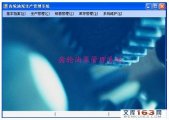齿轮油泵生产的零件管理系统设计(含任务书,开题报告,外文翻译,毕业论文21000字,进度检查表,程序代码)
摘 要
伴随着我国工业的迅速发展,尤其是各大工厂的迅速崛起以及国内制造业的蒸蒸日上。同时,随着中小型制造公司的越来越多,竞争的愈来愈激烈。各大企业为了在竞争日趋激烈的市场获得最大的利润,纷纷提高各自工厂的生产效率,为了使工厂效益最大化,工厂在各自的制造生产以及管理环节大下功夫,也就是精益生产在生产方面的体现,因此,如何在竞争如此激烈的市场下站稳脚跟,甚至扩大盈利是各大企业必须面临的问题!如何利用现代化先进的管理手段,提高公司的管理水平,已经成为制造业发展的当务之急!
在工业社会向信息社会发展的时代,外部环境的动荡和复杂性日益增长,要求企业的决策更加正规化和科学化,信息交换更加频繁,参与决策的人员不断增加,要求举行更多会议的压力同举行更多会议的阻力的矛盾将更加突出。而信息系统可以帮助人们提高决策的效率和效果,通过系统迅速取得准确的依据。利用科技手段提高企业的生产效率以及管理成效无疑是首选的方案,虽然计算机管理并不是制造业管理走向成功的唯一元素,但它可以最大限度的发挥准确,快捷,高效等作用,对公司的协调管理提供强有力的支持,尤其在生产方面,我们的工厂主管以及管理人员可以方便快捷的获知工厂的生产状况,然后做出必要的生产调整,也就是将生产信息化,效率更高,前景很广阔!
关键词:生产信息化;计算机管理;生产状况
Abstract
Along with the rapid development of China's industry, especially the rapid rise of large factories and domestic manufacturing flourishing. Meanwhile, with more and more small and medium-sized manufacturing companies, competition is increasingly fierce. Major companies in order to maximize profits in an increasingly competitive market, have increased the productivity of each plant, in order to maximize the benefits of the plant, the plant great efforts in their respective manufacturing and management aspects, that is, lean production in terms of production the embodiment, therefore, how to gain a firm foothold in such a competitive market, and even expand its profit major companies must face! How to use modern advanced management tools to improve the management level of the company, has become the top priority of the development of the manufacturing industry
In the development of the industrial society to the information society era, the turbulence of the external environment and increasingly complex, requiring the more formal and scientific decision-making, more meetings pressure resistance contradiction with more meetings will become more prominent. Information systems can help people to improve the efficiency and effectiveness of the decision-making through the system quickly obtain accurate basis, to resolve their differences, to make correct and timely reaction to changes. Use of technological means to improve the productivity and effectiveness of the management of the enterprise is undoubtedly the preferred solution, but it can maximize accurate, fast and efficient role in the coordination of the company management to provide strong support, especially in terms of production, our factory executives and managers can easily and quickly informed of factory production status, and then make the necessary production adjustment, that is, the production of information technology, more efficient, the outlook is very Wide!
Key words: Production information Computer Management Production status
研究内容
① 调查研究、查阅文献和搜集资料;
② 阅读和翻译与研究内容有关的外文资料;
③ 撰写开题报告或文献综述,确定设计方案或研究方案;
④ 掌握visual studio等可视化编程工具;
⑤ 详细设计方法(包括控制流程图、功能模块、数据流图、程序框图、开发关键技术等)或研究方法 ;
⑥ 设计或有关计算的源程序(或论点的证明或验证);
⑦ 撰写毕业设计(论文);
拟采取的研究方法、技术路线、实验方案及可行性分析
(1)实验方案
本课题的是根据一个车间的零件实际情况开发工作的,开发一个试用与此车间零件的信息管理系统。基于B/S结构的网络版零件信息管理系统已经时零件管理模式的主流。本系统采用动态网页编程的最新技术——JSP技术开发基于B/S结构的零件信息管理系统,在功能上力求满足该车间日常管理的需求,通过各种功能模块的设计完成了企业利用Internet实现对零件信息进行管理的要求。通过建立基于B/S结构的零件信息管理系统,实现管理人员对零件信息管理的高效率和低成本,提高车间生产的工作效率,达到人、财、物尽其用,开源节流的目的。
(2)研究方法
本课题的主要工作通过采用基于c语言的JSP技术构造动态网页,充分发挥c语言所独有的易用性、跨平台性和安全性,运行效率高、安全可靠、使用性广的员工信息管理系统。
开发环境
由于大多数公司内部使用的计算机平台都是基于Windows环境的。为了降低系统成本, 应最大程度地利用现有的资源、兼容现有的环境,可确定使用下面的开发环境:
网络操作系统:Windows2000;
数据库服务器:MicrosoftSQLServer2005;
服务器平台:Windows2000;
客户机平台:Windows95/98/NT/2000;
前端开发工具:visual studio 2005;
目 录
摘 要 III
ABSTRACT IV
目 录 V
1 绪论 1
1.1 课题背景目的与意义 1
1.1.1 课题背景 1
2 机械零件管理系统的开发技术 4
2.1 C#简介 4
2.2 开发工具 4
2.3 开发环境 5
3 系统分析 6
3.1 可行性分析 6
3.1.1 技术可行性 6
3.1.2 社会可行性 6
3.2 系统流程 7
3.3 业务流分析 7
4 系统设计 9
4.1 系统设计思想目标统设计 9
4.2 系统设计原则 9
4.3 系统功能需求分析 10
4.4 业务流程分析 10
4.5 系统功能模块设计 12
4.6 系统工作流程 18
4.6.1 登录流程 18
4.6.2 零件信息管理模块流程分析 19
5 系统数据库设计 21
5.1 数据库需求分析 21
5.2 数据库概念结构设计 22
5.3 数据库逻辑结构设计 24
6 系统功能的实现 27
6.1 系统登录模块设计 27
6.2 主界面模块设计. 28
6.3 车间合格产品模块设计 29
6.4 车间次品模块设计 32
6.5 仓库零件管理模块设计 33
6.6 车间生产人员模块设计 35
7 系统测试 38
7.1 测试目标与方案 38
7.1.1 系统测试类型 38
7.1.2 系统开发难点与解决方法 38
7.2测试的过程与结果分析 39
8 结论和展望 40
8.1 结论 40
8.2 不足之处及未来展望 40
致 谢 42
参考文献 43
|













